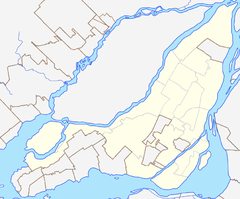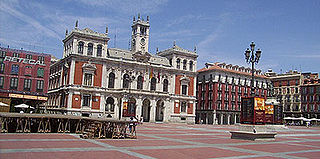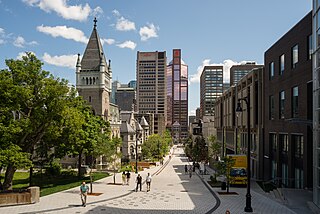
The architecture of Montreal, Quebec, Canada is characterized by the juxtaposition of the old and the new and a wide variety of architectural styles, the legacy of two successive colonizations by the French, the British, and the close presence of modern architecture to the south. Much like Quebec City, the city of Montreal had fortifications, but they were destroyed between 1804 and 1817.

Place Ville Marie is a large office and shopping complex in central Montreal, Quebec, Canada, comprising four office buildings and an underground shopping plaza. The main building, 1 Place Ville Marie, built in the International style in 1962 as headquarters for the Royal Bank of Canada, which it still is presently. It is a 188 m (617 ft), 47-storey, cruciform office tower. The complex is a nexus for Montreal's Underground City, the world's busiest, with indoor access to over 1,600 businesses, several subway stations, a suburban transportation terminal, and tunnels extending throughout downtown. A counter-clockwise rotating beacon on the rooftop lights up at night, illuminating the surrounding sky with up to four white horizontal beams that can be seen as far as 50 kilometres (31 mi) away.

1000 de la Gauchetière is a skyscraper in Montreal, Quebec, Canada. It is named for its address at 1000 De la Gauchetière Street West in the city's downtown core. It is Montreal's tallest building. It rises to the maximum height approved by the city at 205 m and 51 floors. A popular feature of this building is its atrium which holds a large ice skating rink.

Nuns' Island is an island located in the Saint Lawrence River that forms a part of the city of Montreal, Quebec. It is part of the borough of Verdun.

Bonaventure is a Montreal Metro station in the borough of Ville-Marie in Montreal, Quebec, Canada. It is operated by the Société de transport de Montréal (STM) and serves the Orange Line. It opened on February 13, 1967, four months after most of the initial network. It served as the western terminus of the Orange Line for 14 years until the extension to Place-Saint-Henri station opened in 1981.

Ville-Marie is the name of a borough (arrondissement) in the centre of the city of Montreal, Quebec. The borough is named after Fort Ville-Marie, the French settlement that would later become Montreal, which was located within the present-day borough. Old Montreal is a National Historic Site of Canada.

René Lévesque Boulevard, previously named Dorchester Boulevard/Boulevard Dorchester) is one of the main streets in Montreal, Quebec, Canada.
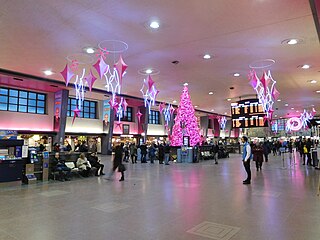
The Montreal Central Station is the major inter-city rail station and a major commuter rail hub in Montreal, Quebec, Canada. Nearly 11 million rail passengers use the station every year making it the second-busiest train station in Canada.

Bishop Street is a north-south street located in downtown Montreal, Quebec, Canada. With a total length of 0.6 km, it links Sherbrooke Street in the north to René Lévesque Boulevard in the south. Like neighbouring Crescent Street, Bishop is home to many pubs, bars, clubs and restaurants.

Peel Street (officially in French: rue Peel) is a major north-south street located in downtown Montreal, Quebec, Canada. The Street links Pine Avenue, near Mount Royal, in the north and Smith Street, in the Southwest borough, in the south. The street's southern end is at the Peel Basin of the Lachine Canal. The street runs through Montreal's shopping district. The Peel Metro station is named for the street.
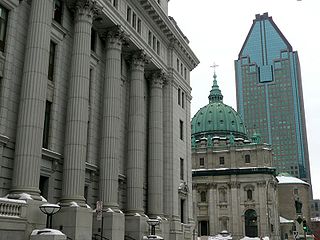
Metcalfe Street is a north-south street located in downtown Montreal, Quebec, Canada. It links Sherbrooke Street in the north and René Lévesque Boulevard in the south. It is best known for being the street on which the Sun Life Building, Mary, Queen of the World Cathedral, and other notable buildings are located. South of René Lévesque Boulevard, the street is known as Cathedral Street. The street borders the eastern side of both Dorchester Square and Place du Canada, to the south.
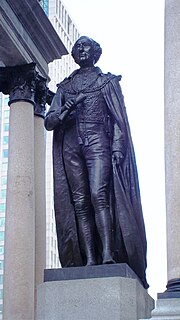
The Macdonald Monument is a monument of sculptor George Edward Wade located at Place du Canada in Montreal.

The Boer War Memorial is a monument of sculptor George W. Hill located at Dorchester Square in downtown Montreal, in Quebec, Canada.
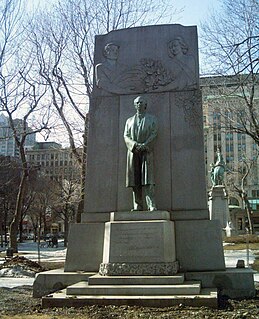
The Wilfrid Laurier Memorial is a monument in Downtown Montreal.

The Cenotaph is a public monument in Montreal, Quebec, Canada, commemorating the First and Second World Wars and Korean War.
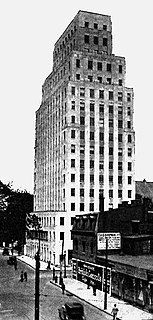
The Architects' Building was an office building located in Montreal, Quebec, Canada. It was located at 1135 Beaver Hall Hill, on the southeast corner of Dorchester Boulevard in Downtown Montreal.


